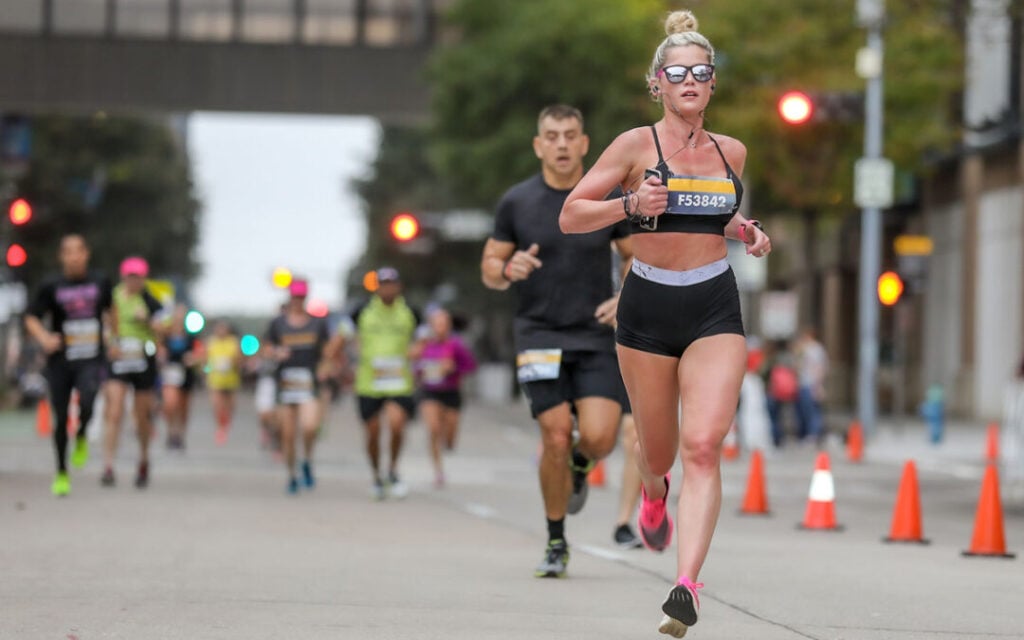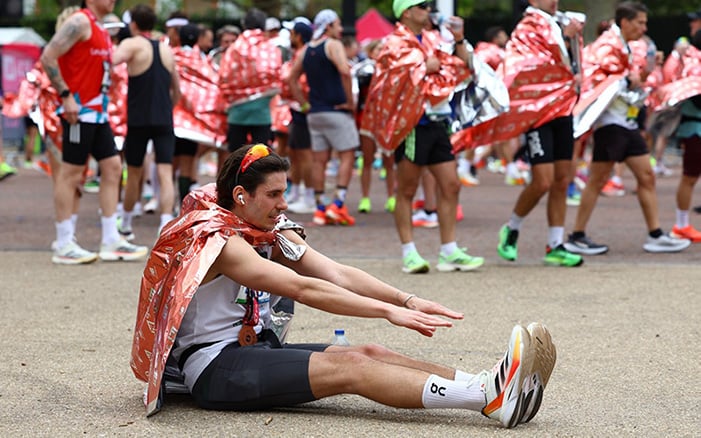You’re logging the miles, but your times stay the same. Few things frustrate a runner more than working harder without getting faster. What you should know is that speed doesn’t come from mileage alone.
If you’re stuck at the same pace and can’t seem to break through, these nine reasons may explain why.
1. You run all your miles at the same pace and your training lacks quality sessions
Many runners fall into the trap of running everything at “medium.” Easy days aren’t easy enough to build recovery, and hard days aren’t hard enough to create adaptation. Over time, this gray zone leaves you fit but flat.
To get faster, you need contrast: truly easy running most days and dedicated harder efforts twice or three times a week. Think of it as building an aerobic base with your easy runs and sharpening speed with intervals, hills, or tempo work.
Both ends of the spectrum matter—without them, your fitness stagnates.
Here’s how a varied week might look for a mid-level runner logging 30–35 miles:
- Monday: 4 miles easy recovery run (conversational pace)
- Tuesday: Intervals, e.g., 6×400m at 5K pace with equal jog recovery
- Wednesday: Rest or cross-training (cycling, swimming, strength training)
- Thursday: 5–6 miles steady aerobic run (comfortably hard, not race effort)
- Friday: 3 miles easy + short strides (20–30 seconds at fast but controlled pace)
- Saturday: Long run, 8–10 miles at easy pace (last 2 miles slightly faster)
- Sunday: Rest, short recovery jog, or strength training
Download for free: 17 training plans—from 5K to marathon
The key is purposeful variation—that kind of mix teaches your body to shift gears. Easy runs build the base, intervals or tempo runs sharpen speed, and long runs grow endurance. That balance is what creates real speed gains over time.
Mileage matters, but not all miles count the same. Running more and more at an easy shuffle eventually turns into what coaches call “junk miles”—volume that leaves you tired but not faster. Progress comes from specific workouts layered on top of a solid base. Without these pieces, mileage is just background noise.
Related: How to Run Faster After 40—Without Getting Injured
2. You avoid speedwork or do it poorly
At some point, you need to practice running fast. Many runners avoid it because it feels uncomfortable. Others hammer speedwork too hard, turning every interval into a race, then wonder why they burn out.
When it’s done well, speed training helps you handle higher workloads, improves running economy, and teaches you to stay relaxed under pressure—benefits that eventually show up as faster times in races. When it’s done poorly, it leaves you overtrained and flat.
Workouts should be controlled, repeatable, and matched to your current fitness. Here are examples of effective speedwork:
- Strides (20–30 seconds fast, full recovery): Improve turnover and reinforce good form. Add 4–6 strides at the end of easy runs once or twice a week.
- Intervals (VO₂ max): 6×400m at 5K pace with equal jog recovery, or 4×800m at 10K pace. Sharp but manageable; you should finish tired but not destroyed.
- Tempo runs (lactate threshold): 20–30 minutes at “comfortably hard” pace (roughly what you could hold for an hour). Builds strength to run faster for longer.
- Hill repeats: 8×45 seconds uphill at 5K effort with jog back recovery. Build power, improve form, and reduce injury risk compared to flat intervals.
One structured session like this each week, plus strides on another day, is plenty. Rotate between intervals, tempo, and hills. Keep the rest of the week easy enough to absorb the work.
Related: How to Do Strides—The Easiest Drill to Run Faster
3. You neglect strength training
Weak hips, glutes, and core muscles limit stride power and efficiency. If those muscles can’t support the load, your form breaks down and injuries creep in.
Strength training doesn’t require a complicated gym program. Two sessions a week of basics—squats, lunges, deadlifts, push-ups, planks—are enough to change how you move.
Stronger legs deliver more force with each stride, and a stronger core holds your posture late in races. Think of it as building the frame that lets your engine run at full speed.
4. You ignore form and mechanics
Even well-trained runners leak energy through poor mechanics. Overstriding, slumping posture, weak arm swing—small flaws repeated thousands of times add up to wasted effort.
Adding drills helps reset movement patterns: high knees, skips, strides, hill sprints. Mobility work for hips and ankles opens up range of motion.
None of this replaces training, but it raises the return you get from every mile. Clean form is free speed—you don’t have to run more to get it, you just have to run better.
5. You’re always racing, never training
Some runners turn every run into a test of fitness. Strava segments, time trials, daily “PR attempts,” races every weekend. The problem is that you never build, you only measure.
An efficient training cycle includes base building, intensity, a peak, then recovery. If you’re racing every week, you never give your body the time to adapt.
Save your best efforts for race day. Training is supposed to prepare you for racing, not replace it.
6. You don’t recover enough
More isn’t always better. Without enough recovery, fatigue piles up and performance flatlines.
The warning signs are familiar: constant tiredness, poor sleep, workouts that feel harder than they should.
The fix is simple but rarely easy—take recovery as seriously as training.
That means easy runs that are genuinely easy, rest days without guilt, balanced fueling, and seven to nine hours of sleep most nights.
The best runners in the world improve not because they train nonstop, but because they balance stress and rest better than anyone else.
Related: The Ultimate Post-Run Recovery Guide
7. Your nutrition doesn’t match your training
Speed won’t show up if you aren’t fueling to support it. Skimping on protein slows repair. Under-eating carbohydrates leaves you flat in workouts. Low iron drains your endurance. Many runners eat “healthy” but not necessarily “enough” for the volume they do.
Support each run with the right building blocks: protein in every meal, carbs timed before and after harder sessions, iron-rich foods to keep energy high, etc.
If you’re always dragging, it’s not just training, it may be underfueling, because food is the material that makes adaptation possible.
8. You overlook mental training
Many runners plateau not because their body can’t go faster, but because their mind tells them to back off.
Mental endurance isn’t abstract—you can train it the same way you train speed. You can train the ability to stay in the effort when it gets uncomfortable. Here are a few ways to build it:
- Practice goal pace in workouts. Run parts of tempos or long runs at target race pace until the effort feels familiar.
- Break long efforts into smaller parts. Focus on the next mile, or the next five minutes, instead of the entire distance.
- Notice negative thoughts, don’t follow them. Fatigue brings doubt; acknowledge it without letting it dictate your pace.
- Use cues. A simple word—“drive,” “steady,” “relax”—repeated in a hard patch keeps your focus anchored.
You can’t separate mental training from physical one, it happens inside it. Treat every workout as a chance to rehearse the focus you’ll need when racing gets difficult.
9. You’re stuck in the same training cycle
One of the most overlooked reasons runners stagnate is repetition.
You repeat the same mileage, the same workouts, the same race prep, year after year. It worked once, so you go back to it again and again. The problem is that your body has already adapted. What used to feel challenging no longer pushes you forward.
The way out is progression. Build a bigger base, increase long run distance, add new workouts, or focus on a different race distance before coming back to your main goal.
Periodization isn’t just a buzzword, but the structure that keeps adaptation moving. Stay in the same cycle, and you’ll keep getting the same results.
Final thoughts
More miles alone won’t make you faster. Progress comes from variety, from quality sessions balanced with recovery, from strength training and proper fueling, from better mechanics, and from training the mind as well as the body.
If you’re frustrated with your progress, don’t assume you need to double your mileage. Look at these nine areas instead. Address even one or two, and you’ll give your training the push it’s been missing.












